2011 Peugeot 508 Fuel pump
[x] Cancel search: Fuel pumpPage 60 of 340
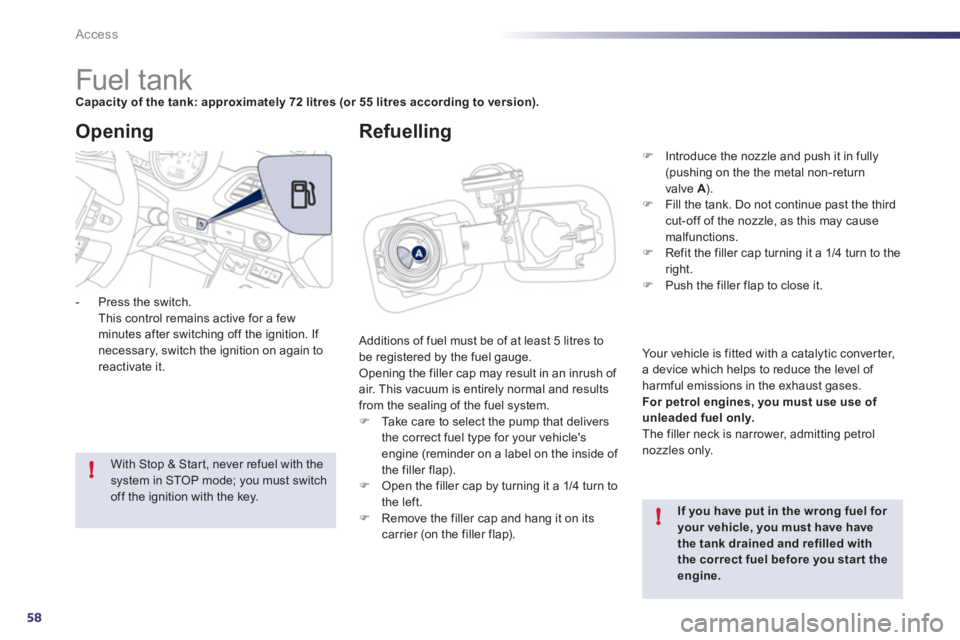
58
!
!
Access
Fuel tank
Capacity of the tank: approximately 72 litres
(or 55 litres according to version).
Additions of fuel must be of at least 5 litres to
be registered by the fuel gauge.
Opening the filler cap may result in an inrush of
air. This vacuum is entirely normal and results
from the sealing of the fuel system.
�)
Take care to select the pump that delivers
the correct fuel type for your vehicle's
engine (reminder on a label on the inside of
the filler flap).
�)
Open the filler cap by turning it a 1/4 turn to
the left.
�)
Remove the filler cap and hang it on its
carrier (on the filler flap).
Opening
If you have put in the wrong fuel for
your vehicle, you must have have
the tank drained and refilled with
the correct fuel before you star t the
engine.
With Stop & Star t, never refuel with the
system in STOP mode; you must switch
off the ignition with the key.
- Press the switch.
This control remains active for a few
minutes after switching off the ignition. If
necessary, switch the ignition on again to
reactivate it.
Refuelling
�)
Introduce the nozzle and push it in fully
(pushing on the the metal non-return
valve A
).
�)
Fill the tank. Do not continue past the third
cut-off of the nozzle, as this may cause
malfunctions.
�)
Refit the filler cap turning it a 1/4 turn to the
right.
�)
Push the filler flap to close it.
Your vehicle is fitted with a catalytic conver ter,
a device which helps to reduce the level of
harmful emissions in the exhaust gases.
For petrol engines, you must use use of
unleaded fuel only.
The filler neck is narrower, admitting petrol
nozzles only.
Page 61 of 340
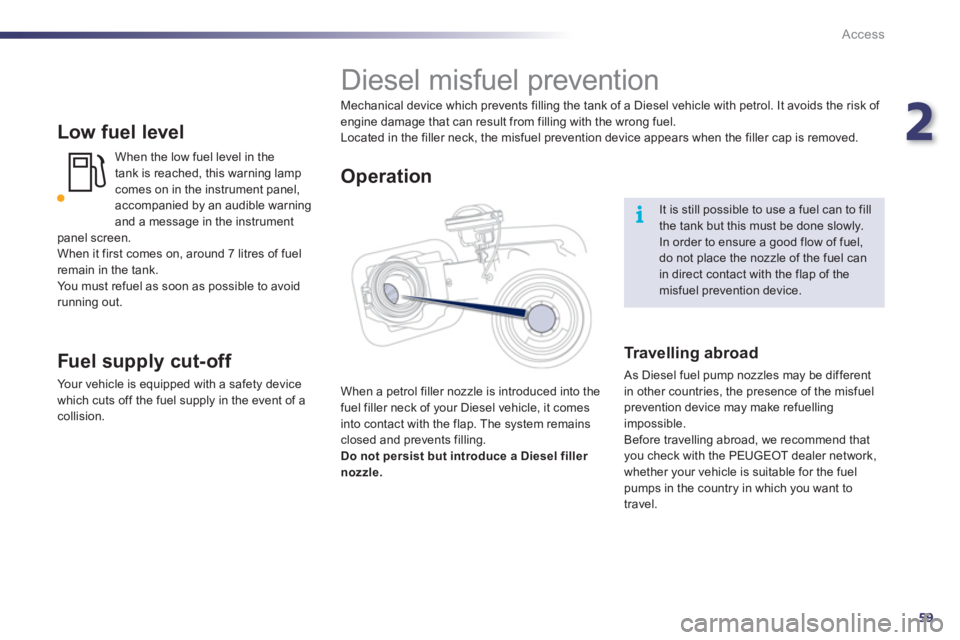
2
59
i
Access
Low fuel level
When the low fuel level in the
tank is reached, this warning lamp
comes on in the instrument panel,
accompanied by an audible warning
and a message in the instrument
panel screen.
When it first comes on, around 7 litres of fuel
remain in the tank.
You must refuel as soon as possible to avoid
running out.
Fuel supply cut- of f
Your vehicle is equipped with a safety device
which cuts off the fuel supply in the event of a
collision.
It is still possible to use a fuel can to fill
the tank but this must be done slowly.
In order to ensure a good flow of fuel,
do not place the nozzle of the fuel can
in direct contact with the flap of the
misfuel prevention device.
Diesel misfuel prevention
Mechanical device which prevents filling the tank of a Diesel vehicle with petrol. It avoids the risk of
engine damage that can result from filling with the wrong fuel.
Located in the filler neck, the misfuel prevention device appears when the filler cap is removed.
When a petrol filler nozzle is introduced into the
fuel filler neck of your Diesel vehicle, it comes
into contact with the flap. The system remains
closed and prevents filling.
Do not persist but introduce a Diesel
filler
nozzle.
Operation
Tr a v e l l i n g a b r o a d
As Diesel fuel pump nozzles may be different
in other countries, the presence of the misfuel
prevention device may make refuelling
impossible.
Before travelling abroad, we recommend that
you check with the PEUGEOT dealer network,
whether your vehicle is suitable for the fuel
pumps in the country in which you want to
travel.
Page 62 of 340
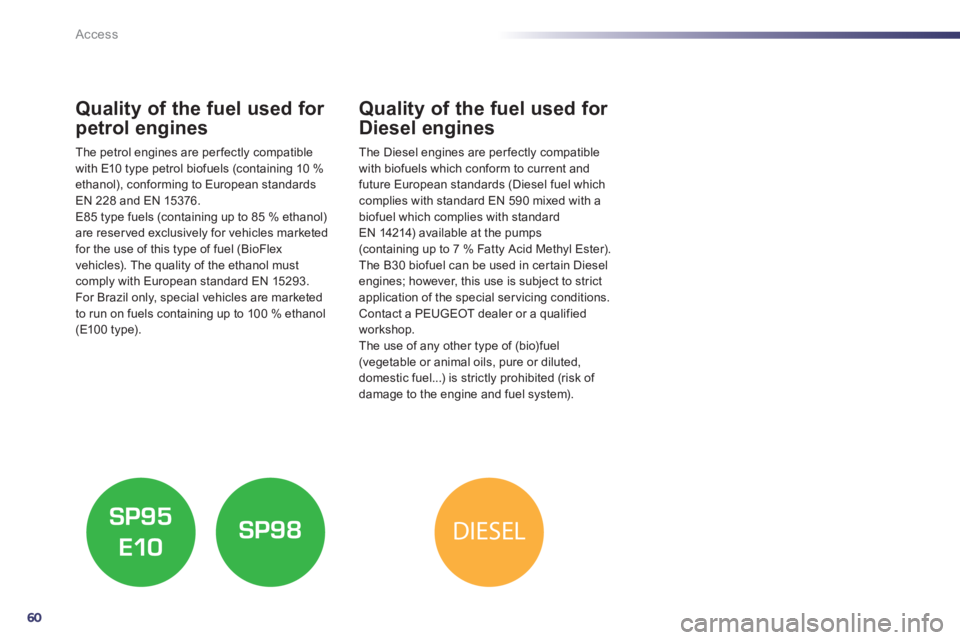
60
DIESEL
Access
Quality of the fuel used for
petrol engines
The petrol engines are per fectly compatible
with E10 type petrol biofuels (containing 10 %
ethanol), conforming to European standards
EN 228 and EN 15376.
E85 type fuels (containing up to 85 % ethanol)
are reser ved exclusively for vehicles marketed
for the use of this type of fuel (BioFlex
vehicles). The quality of the ethanol must
comply with European standard EN 15293.
For Brazil only, special vehicles are marketed
to run on fuels containing up to 100 % ethanol
(E100 type).
Quality of the fuel used for
Diesel engines
The Diesel engines are per fectly compatible
with biofuels which conform to current and
future European standards (Diesel fuel which
complies with standard EN 590 mixed with a
biofuel which complies with standard
EN 14214) available at the pumps
(containing up to 7 % Fatty Acid Methyl Ester).
The B30 biofuel can be used in cer tain Diesel
engines; however, this use is subject to strict
application of the special ser vicing conditions.
Contact a PEUGEOT dealer or a qualified
workshop.
The use of any other type of (bio)fuel
(vegetable or animal oils, pure or diluted,
domestic fuel...) is strictly prohibited (risk of
damage to the engine and fuel system).
Page 211 of 340
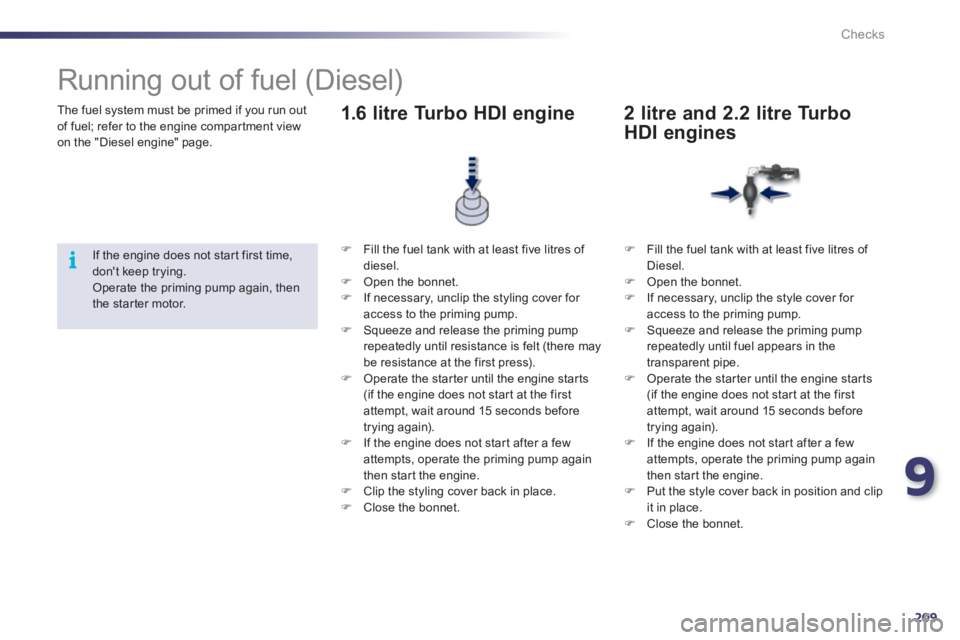
9
209
i
Checks
The fuel system must be primed if you run out
of fuel; refer to the engine compar tment view
on the "Diesel engine" page.
Running out of fuel (Diesel)
If the engine does not star t first time,
don't keep trying.
Operate the priming pump again, then
the star ter motor.
�)
Fill the fuel tank with at least five litres of
diesel.
�)
Open the bonnet.
�)
If necessary, unclip the styling cover for
access to the priming pump.
�)
Squeeze and release the priming pump
repeatedly until resistance is felt (there may
be resistance at the first press).
�)
Operate the star ter until the engine star ts
(if the engine does not star t at the first
attempt, wait around 15 seconds before
trying again).
�)
If the engine does not star t after a few
attempts, operate the priming pump again
then star t the engine.
�)
Clip the styling cover back in place.
�)
Close the bonnet.
1.6 litre Turbo HDI engine
�)
Fill the fuel tank with at least five litres of
Diesel.
�)
Open the bonnet.
�)
If necessary, unclip the style cover for
access to the priming pump.
�)
Squeeze and release the priming pump
repeatedly until fuel appears in the
transparent pipe.
�)
Operate the star ter until the engine star ts
(if the engine does not star t at the first
attempt, wait around 15 seconds before
trying again).
�)
If the engine does not star t after a few
attempts, operate the priming pump again
then star t the engine.
�)
Put the style cover back in position and clip
it in place.
�)
Close the bonnet.
2 litre and 2.2 litre Turbo
HDI engines
Page 213 of 340
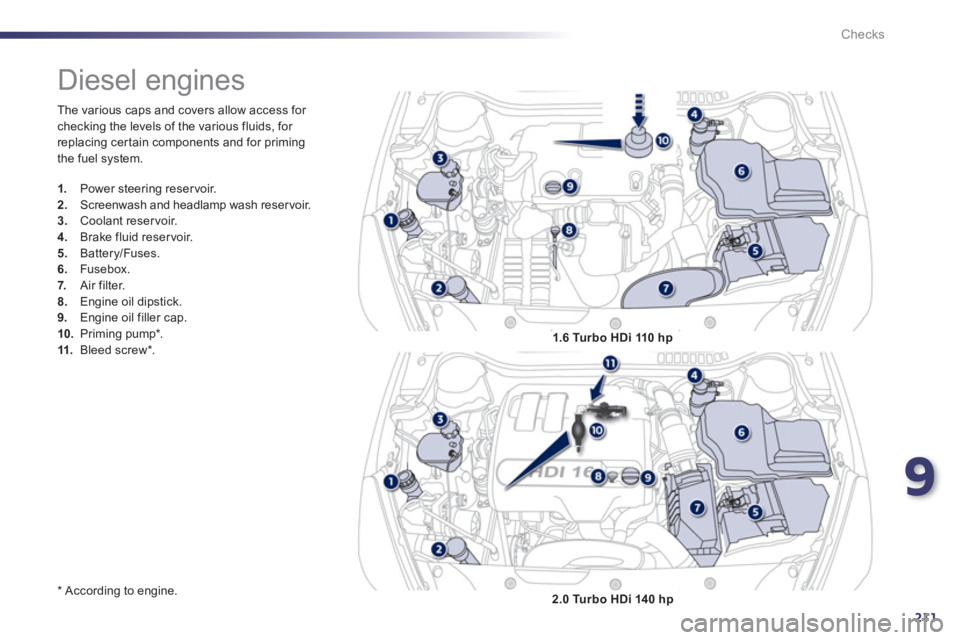
9
211
Checks
The various caps and covers allow access for
checking the levels of the various fluids, for
replacing cer tain components and for priming
the fuel system.
*
According to engine.
Diesel engines
1.
Power steering reservoir.
2.
Screenwash and headlamp wash reser voir.
3.
Coolant reser voir.
4.
Brake fluid reser voir.
5.
Battery/Fuses.
6.
Fusebox.
7.
Air filter.
8.
Engine oil dipstick.
9.
Engine oil filler cap.
10.
Priming pump * .
11.
Bleed screw * .
1.6 Turbo HDi 110 hp
2.0 Turbo HDi 140 hp
Page 214 of 340
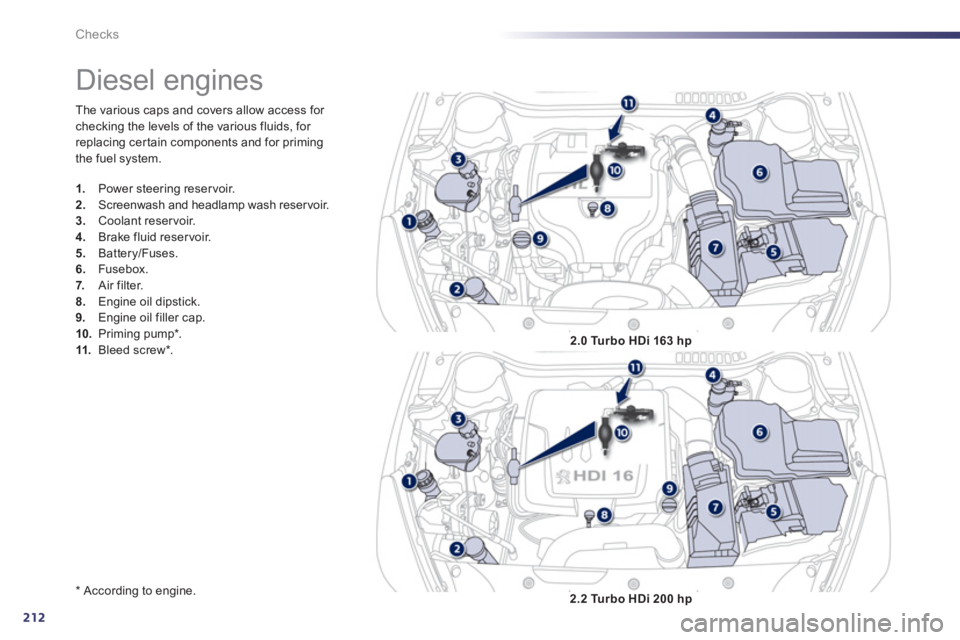
212
Checks
The various caps and covers allow access for
checking the levels of the various fluids, for
replacing cer tain components and for priming
the fuel system.
*
According to engine.
Diesel engines
1.
Power steering reservoir.
2.
Screenwash and headlamp wash reservoir.
3.
Coolant reser voir.
4.
Brake fluid reser voir.
5.
Battery/Fuses.
6.
Fusebox.
7.
Air filter.
8.
Engine oil dipstick.
9.
Engine oil filler cap.
10.
Priming pump * .
11.
Bleed screw * .
2.0 Turbo HDi 163 hp
2.2 Turbo HDi 200 hp